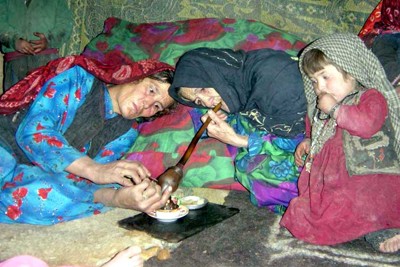By Candace Rondeaux
KABUL -- The first days were so painful that Mina Gul could barely sit upright. Thin and lanky with wide brown eyes, she rubbed the back of her neck ceaselessly with fingers stained reddish black by an opium pipe. She couldn't shake the nausea. The light was almost blinding in the clean, white-walled medical clinic, where she lay crumpled in bed for days.

Ministry of Counter Narcotics and U.N. Office on Drugs and Crime, found nearly 1 million addicts in this nation of about 30 million people, including 60,000 children under age 15.
Before that, opium had been about the only thing keeping Gul afloat. It started four years ago with the headaches. A relative told her to try a bit of opium as a cure. "I tried it once a little -- then the next day more, then more again, and then I was addicted," Gul said.
Since then, her husband has stopped working and the eldest of her four children is more often on the streets than in school. Gul, 36, is spending most of her time in a hospital bed.
Gul is one of 20 women in residential treatment at the Sanga Amaj center in Afghanistan's capital. The small, two-story clinic near Kabul University is one of 40 drug treatment clinics across Afghanistan run by international aid organizations.
More than six years after U.S.-led forces launched a military campaign here against the ruling Taliban movement, drug addiction is fast becoming a major concern for the government. With opium production reaching an all-time high of 6,000 tons last year, according to the United Nations, domestic addiction rates in this nation of nearly 32 million have also soared. A 2005 U.N. report estimated that Afghanistan was home to about 1 million drug abusers.
Among the country's addicts, about 13 percent are women and 7 percent are children, Afghan government officials say. Most of the women are opium addicts desperate to blunt the trauma of endless war. Many are illiterate mothers with unemployed husbands. Most have little in the way of job skills, and some became addicts while picking opium poppies to earn a living and support their families, said Zalmai Afzali, a spokesman for the Afghan Ministry of Counternarcotics.
"Afghanistan has been ravaged by 30 to 35 years of war. Everything has been destroyed here, so it's not surprising that people turn to drugs," Afzali said.
High rates of addiction have forced aid organizations to step in to fill the vacuum left by a government still struggling with an insurgency, meager resources and endemic corruption. The number of drug treatment clinics has doubled during the past two years, Afzali said, with an additional 34 mobile treatment clinics for women operating across the country.
Treatment for female addicts is especially difficult, experts here say, because women in rural, conservative parts of the country -- particularly in places such as Helmand province in the south, the world's largest opium-producing region -- are often not allowed out of the house. While drug addicts around the world endure shame, the stigma for Afghan women who seek treatment can sometimes produce violent responses from their families. In a country where the average per-capita income is about $1,000 a year, addiction for women often leads to desperation.
"We had a patient here who wanted to sell one of her kids," said Toorpekay Zazai, a doctor who heads the Sanga Amaj center. "She said she didn't have enough money to buy food or clothes for him. Finally, we managed to get to her relatives in Canada, who were able to help with some money. But there are lots of stories like that from the women here."
About 300 women have successfully completed treatment at Sanga Amaj since the center opened last June, Zazai said. Women treated by the clinic's three doctors usually stay for at least a month.
The first two weeks are spent purging the body of drugs. Gradually, the women begin participating in group therapy and learning skills such as sewing, embroidery and knitting. Successful treatment ends with a celebratory feast at which residents, staff members and former patients share stories of battling addiction.
For every success there is a relapse, doctors at the clinic say. Women often spend weeks getting clean, only to return to households seized by addiction.
"The risk is that when a woman is an addict, she doesn't get treatment, then it will spread to the entire family," Zazai said.
"We have cases where whole families are addicted, so when the woman goes home from treatment, the husband is still addicted and you have to start all over again."



